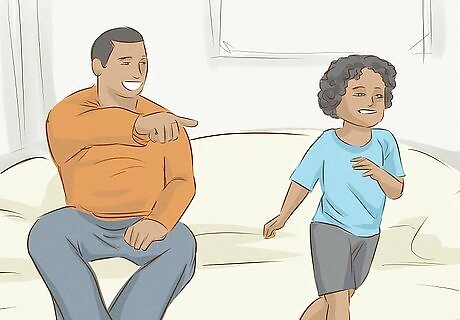
views
Calming Down When You’re Emotional

Take a deep breath. One of the easiest things you can do to help keep from reacting emotionally is to inhale deeply, hold the breath for 2-3 seconds, and exhale slowly. This doesn't need to calm you down completely. Instead, a deep breath helps keep you from exploding in unplanned and emotional ways. Take as many breaths as you need so that you feel prepared to move forward. Your next step may be to keep the conversation going or to remove yourself from the situation temporarily. Either way, you should be able to do so in a cool, collected manner.

Count down to a calm moment. You can practice this mentally to help keep yourself calm, or you can count out loud for your kids. Try slowly counting backward from a number like 5 or 10 down to 1. By the time you reach 1, your goal should be to speak calmly about a situation with your child. If you are counting in your own mind, try taking a deep breath with each number. As you breathe in between each number, let yourself know, "in 4 more counts, I will be calm and collected." If you are counting out loud for your kids, try saying, "I'm going to count down from 5. By the time I reach 1, everyone needs to be speaking with an inside voice." This gives your kids a few seconds to reflect on the situation themselves and adjust their own actions.

Take a moment away from the situation. Provided everyone is safe before you leave, walk away from the situation for a moment. Find a place where you can be alone to gather your thoughts and help get control of yourself. Only return when you feel in control of your emotions. You can even consider designating a certain spot your quiet area. For example, if you have a home office, let your kids know, “I’m going to go sit in the office for a while. Everyone needs to be quiet during this time. We’ll continue this conversation when I come back.” Calming down doesn’t have to mean that you have changed your stance on the situation or that you are giving in. In fact, responding to a situation firmly but calmly often lets a child know that you’re in charge, and that they can’t push your buttons to get what they want. After you step away, do a short meditation to recenter yourself. Simply close your eyes and focus on your breath.

Separate your emotions from theirs. It’s natural to meet your child’s anger with your own, but your kid doesn’t have to dictate your emotions. When your kid responds to you with anger, remind yourself that their emotions are not yours. Tell yourself, “I was calm before they started yelling, and there is no reason for me to not be calm now.” Giving your kids an angry response lets them know they can push your buttons. It’s a way for them to test your authority. Keeping calm shows them that they can’t manipulate your emotions.

Fake your calm. It can be tough to quiet an emotional response. If you can project a calm attitude, though, it can help keep your children calm and responsive. Try to keep your face as neutral as possible, look your kids directly in the eyes, and speak slowly and softly but firmly. When you have resolved the situation or your kids are in another room, let yourself get your emotions out. Write them down, talk through the situation with your partner or a friend, or take some time to work out the stress by jogging, dancing, training or any other physical activity.
Maintaining Your Calm and Controlling Your Emotions

Speak clearly, slowly, and firmly. The balance between gentle and firm can be difficult to find, but it’s incredibly effective. Whether you’re giving instructions or correcting behavior, speaking to your children in a slow, gentle, and firm tone lets them know that you’re in charge of the situation. Keep your words clear and concise to make sure they understand. For example, if your kid pushed another kid at school, let them know, “It wasn’t nice to push your friend. It hurt their feelings and hurt them physically. That’s why we don’t push in this house.” Look your kids in the eyes when you are speaking to them. If possible, try to get close to their eye level. This lets them know you’re serious while also showing them that you respect them enough to communicate directly to them. Remember—your goal isn't to be extra authoritative. Instead, you want to help your child learn from their mistake.

Be consistent in your requests. It’s a natural temptation to budge on your requests to get things to calm down. Consistency will ultimately help set expectations for the future, though, and keep your kids calm in those situations. Acknowledge your child’s feelings, but stay firm on your requests. Use “I” statements to express how you feel and what you want. If, for example, your child doesn’t like what you made for dinner, let them know, “I’m sorry that you don’t like the meal I made for us. I still expect you at the dinner table at 7 p.m., though.” This doesn’t mean you shouldn’t ever budge. For example, if you tell your teen they can’t stay out past curfew but they let you know it’s for a study session, it’s perfectly reasonable to compromise with them based on that new information.

Ask questions to help your child contextualize their actions. Both younger and older kids fear judgement and try to avoid criticism. Instead of offering unsolicited advice, ask your kid questions to help them think through difficult situations for themselves. If your younger child doesn’t understand why they should be honest, for example, you can ask them, “How would you feel if I lied and told you something, then later you found it it wasn’t true? Would you be happy?” For an older child who wants to quit a school play halfway through the rehearsal period to have more free time, ask them, “How would you feel if you had to stop doing something you loved because one of your peers didn’t want to keep their commitment?”

Take your time. Whether they are just excited or demanding something from you, it’s easy to feel rushed by your kids. Instead of stressing to meet their demands, though, remind yourself that you can take as much time as you need. You know your schedule and your kid’s, and no matter how urgent your child thinks the situation is, you still have time. This goes for in-the-moment scenarios, as well as decisions. You don’t need to rush to make a decision just because your child wants an answer. Give them a deadline such as, “I’ll let you know before Friday.” Then take as much time as you need.
Responding Calmly Everyday

Help younger kids explain their emotions. Part of the reason younger children act out is because they don’t have the tools to express themselves. If your young child is acting out, help them put a name to their emotions and give them an alternate course of action. Never dismiss your child's feelings if they get upset. Instead of telling a crying child to "calm down," ask them if they need a hug, or if they'd like to spend some time by themselves. It's important to give young children the words to express how they feel, as they likely can't do it on their own. You should also model this behavior for them by expressing your own emotions when you feel upset. If, for example, you tell your child they can’t watch TV and they start crying or screaming, let them know, “I understand you’re angry right now. We all get angry sometimes, and that’s okay. But getting angry won’t get your TV time. How about we go color instead?” Alternatively, if your child gets so excited over something positive that they seem upset, like crying when you say you are going to the aquarium, tell them, “I know you’re excited. I’m excited, too! Instead of crying, though, let’s do a happy dance!” Then dance with them.

Allow older children to distance themselves. Middle school and high school-aged children have a developmental need to distance themselves from you as they grow older. It may seem counterintuitive, but it’s actually helpful to give them this distance. The less you pressure them to know the smaller details of their life, the more likely they are to come to you. This doesn’t mean you need to let them do whatever they want with no accountability. Instead, it simply means giving them distance at home or when you’re around one another. If, for example, you and your teen are going to the mall, don’t make them ask to wander around themselves. Instead, tell them, “I need to pick up things from this store. I’ll be there if you need me. If not, meet me at the entrance to the parking garage at noon.” Before you part ways, make sure that your child knows how to contact you in case of an emergency, as well as what to do while they wait for you.

Establish expectations and consequences beforehand. Knowing beforehand what will happen if expectations aren’t met can help keep a situation from getting heated. Sit down with your child and discuss your expectations. Then, talk about what consequences will be in place if they fail to meet those expectations. Let your kid have some input on both the expectations and the consequences. This can help them feel respected and keep them accountable for their actions. For example, if you’re establishing chores you may ask them, “Would you rather take out the trash 3 times a week or do the dishes twice a week?” Then let them know, “If the dishes aren’t done on your days, you won’t get to use tech that night except for homework.”

Avoid aggressive or unclear communication. Aggressive or unclear communication can make your child feel threatened or attacked. Try to stay away from sarcasm, threats, and labeling. Instead of saying, “You’re so selfish!” try saying, “I expect you to contribute to this household by doing the dishes.”



















Comments
0 comment